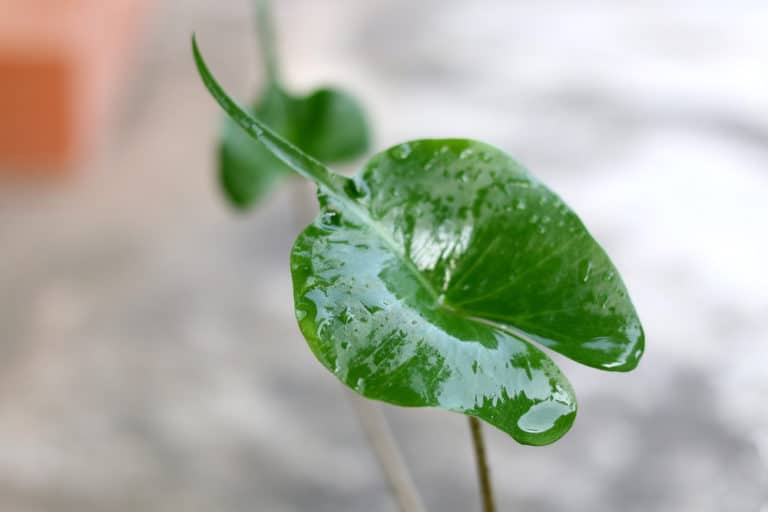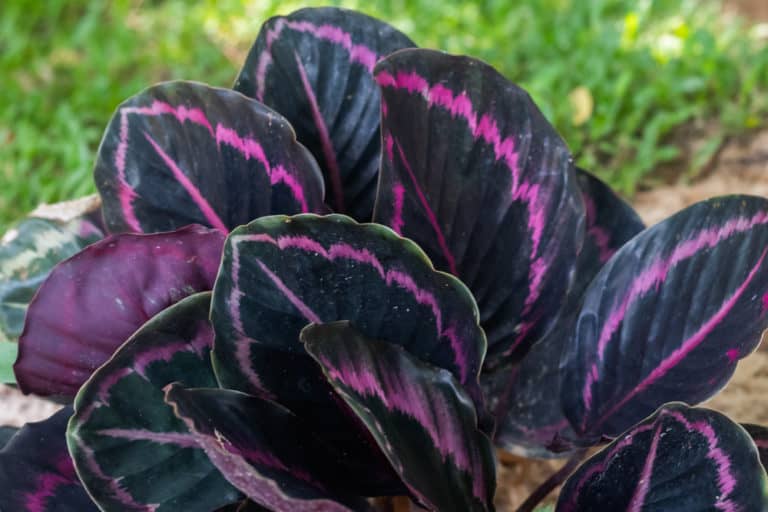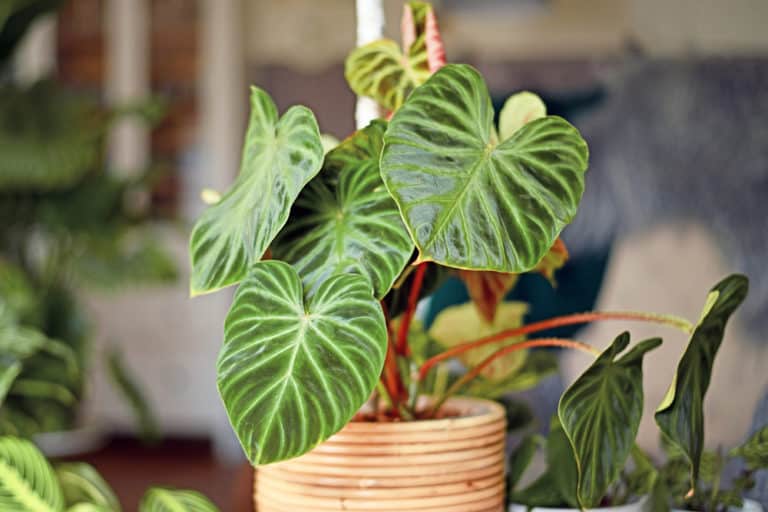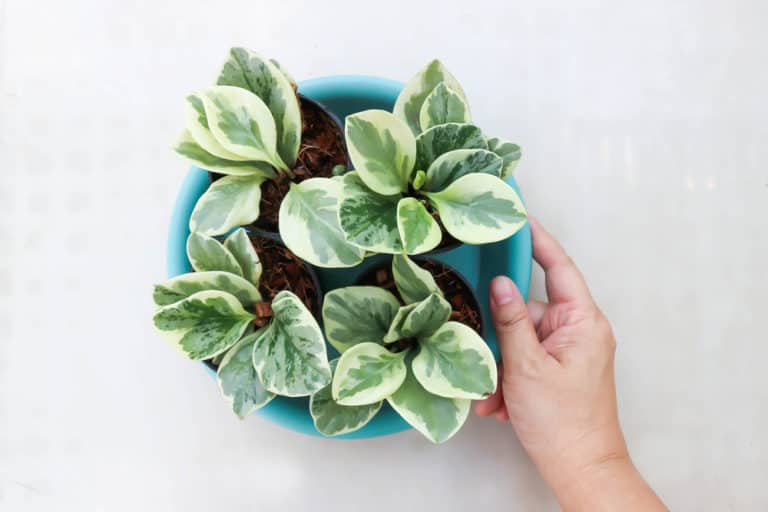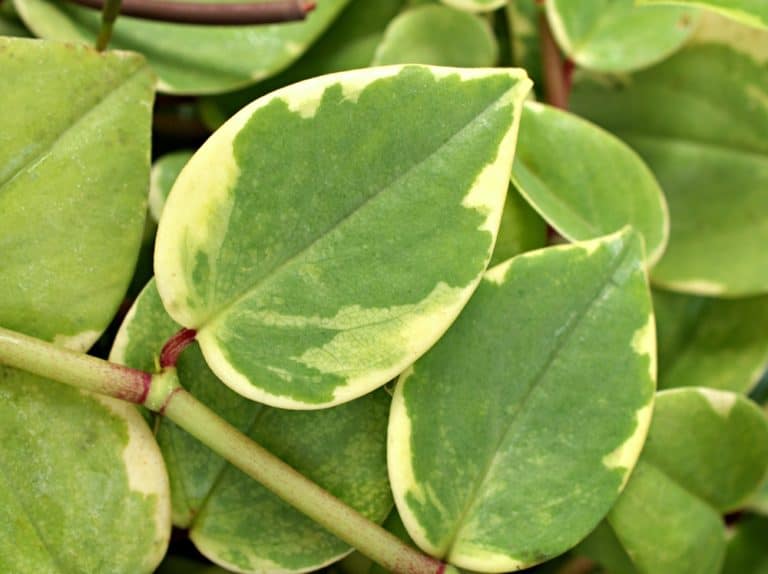Philodendron Hederaceum ‘Moonlight’ Care Guide (2024)

The special thing you’ll notice with Philodendron hederaceum ‘Moonlight’ is its leaves that display a fluorescent look. It’s a highly attractive ornamental species of Philodendron, one that’s quite easy to care for. There’s no reason not to fall in love with Philodendron Moonlight as it’s a great plant for indoors and outdoors.
| Scientific Name | Philodendron hederaceum ‘Moonlight’ |
| Common Name | Moonlight Philodendron, Lime Philodendron |
| Light | Partial shade |
| Watering | Once the soil becomes dry to about 1” inch deep, it’s time to water. |
| Temperature | 65 to 80ºF (18 to 27ºC) |
| Hardiness Zone | USDA Zones 10 to 11 |
| Humidity | 50% percent or higher |
| Soil Type | Moist and free-draining |
| Soil pH | 5.0 – 7.0 (Acid – Neutral) |
| Fertilizing | Once a month in the spring and summer months, all-purpose balanced liquid fertilizer |
| Repotting | Late spring or early summer, every year |
| Pruning | Spring or autumn |
| Propagation | Divisions or stem cuttings |
| Toxicity | Toxic to pets and humans |
| Mature Size | Height of 20 to 24 feet; width of 20 to 26 inches |
| Bloom Time | Between spring and summer |
What’s Unique About Philodendron Moonlight?
Aside from having those luminous leaves, the Philodendron Moonlight plant has an air-purifying ability. This makes this plant suited for indoor conditions as it helps filter the air from pollutants. Compared to other Philodendron species, this one is low-growing. It will do well even when planted in pots.
Philodendron Moonlight is a hybrid variety of Philodendron. And its parent plants are native to the tropical and subtropical canopies of Central and South America. Some gardeners refer to it as Moonlight Philodendron or Lime Philodendron. This is a must addition to your plant collection, especially if you’re a fan of unique foliage plants.
Philodendron Moonlight Care
Three basic things are critical when it comes to Philodendron Moonlight plant care. One is proper sunlight. Another is ample watering. And third is the provision of enough nutrients. Care and maintenance are relatively easy. This plant suits the skills of a newbie gardener.
Following are more detailed tips involving Philo Moonlight care.
Light
An east-facing window is a perfect spot to satisfy the Philo Moonlight light needs. This location would give off a couple of hours of direct sunlight in the morning and indirect sunlight for the rest of the day. Such a condition is what your Philodendron Moonlight likes because it’s pretty sensitive to strong light intensities. Full sun exposure is definitely not good.
If planted outdoors, find a shady spot where it can receive dappled light. It could be under a tree canopy. This mimics the condition from where this plant originates. Partial sunlight is enough to achieve the Philodendron Moonlight light requirements.
Watering
A moderate amount of water is enough to keep the plant happy and healthy. In order to fulfill its watering needs, you have to take note when the soil gets dry to about 1-inch deep. That’s the perfect time to shower your Philodendron Moonlight plants.
Overwatering is common malpractice that could lead to root rot. Hence, you must take serious caution when it comes to Philodendron Moonlight watering. Make sure excess water seeps out of the drainage. Water Philo Moonlight once a week during the summer and spring seasons. But you must adjust it accordingly once the winter season sets in.
Temperature
Philodendron Moonlight temperature range is most ideal between 65 to 80ºF (18 to 27ºC). It loves a warm environment given that it has a tropical origin. A typical indoor temperature is enough to keep it thriving.
Be mindful, though, that its temperature tolerance wouldn’t go below 55ºF (13ºC). So, if your plant is near a window, relocate it somewhere warm during the night. An extremely cold temperature for Moonlight Philodendron is not good. You can also place a curtain in your windows to serve as another layer of protection.
This plant will thrive best outdoors in areas under USDA hardiness zones 10 to 11.
Humidity
High humidity level is the best friend of Philodendron Moonlight. There should be at least 50% or more humidity in the room where it is being kept. Otherwise, you have to make certain adjustments to be able to keep up with the Philodendron Moonlight humidity requirements.
One way to gain the ideal humidity for Moonlight Philodendron is through occasional misting. Do this during the times when the humidity is relatively lower, for example, in winter. If you have a humidifier, that would be better as it saves time and labor. But as a tip, do these things in the morning to allow excess moisture to evaporate throughout the day.
Soil
Nothing beats a moist and well-draining soil for Philo Moonlight. You may opt to choose a soil-based or soilless mixture but make sure that it’s loose. For a soil mix, make sure to add organic matter. For a soilless mix, you can do a combination of peat-vermiculite, peat-perlite, or even 100% sphagnum moss.
These combinations are helpful in achieving a potting mix that will provide enough nutrients, oxygen, and water for the growing Philodendron Moonlight.
The correct ph level for Philo Moonlight is between 5 to 7 (acidic to neutral). We also advise that you sterilize the Philodendron Moonlight soil before planting.
Fertilizer
You need to apply Philodendron Moonlight fertilizer if you want your plant to be lush and healthy. Active seasons such as spring and summer are the best times to regularly feed your plant. You apply all-purpose liquid fertilizer once a month. In terms of fertilizer ratio, it must contain all the macro-nutrients.
You may also use slow-release fertilizer for Philo Moonlight. This will provide a long supply of nutrients through time. During winter and fall, expand the interval of fertilizer application from once a month to every 6 to 8 weeks.
Pro tip: Build-up of fertilizer salts may occur over time. To get rid of them, wash them off with overflowing water repeatedly.
Potting & Repotting
Philodendron Moonlight repotting should be part of your yearly activities. This plant requires regular repotting because it can easily get pot-bound. It’s critical that you give enough room for its roots to grow. Increasing the pot size and replacing the depleted soil is necessary.
Late spring or early summer is the best time for repotting Moonlight Philodendron. Briefly soak the soil to loosen it up making it easy to remove from its pot. Remove excess soil and check the roots. Trim the dead ones. Using a fresh potting mix, place your plant in its new container. Then, water it thoroughly.
Pruning
Philodendron Moonlight pruning is not a regular thing to do. However, it would be extra beneficial to trim off stems and leaves that are out of shape. You should also remove dead, diseased, and aged foliage. This will help prevent the spread of diseases and allow young leaves to develop.
However, just be reminded that cutting Philo Moonlight excessively is not a good practice. This could be dangerous as the plant may struggle to grow back with only a few leaves left. You can simply pinch off just above the nodes of each leaf. The best time to do pruning is during mid-Spring and fall.
Propagation
Learning how to propagate a plant is an important skill. This will help you increase the number of your beloved plant. The best way to propagate Philo Moonlight is through stem cuttings. This method is by far the easiest and most efficient. In order to do it, follow the following steps:
The first step to Philodendron Moonlight propagation is to find a healthy and mature stem where there’s a leaf above its node. Disinfect the pruning shear with alcohol before using it for cutting. Don’t forget to wear your gloves. Smoothly cut the stem at an angle of 45 degrees. Allow the stem to be callous before planting it in a potting mix.
Also, make sure to check out our in-depth Philodendron painted lady care guide.
Common Problems of Philodendron Moonlight
Although this plant is known to be hardy, there are a few Philodendron Moonlight problems that you may encounter. They may get stressed and susceptible at times due to pests and diseases, too. Problems with Philo Moonlight have often been reflected in its leaves. So, there are a few signs and symptoms to watch out for.
Pests
Philo Moonlight is susceptible to bugs such as mealybugs. This tiny organism is characterized by having a white appearance. They’re small and oval in shape. What they do is suck the sap from the plant tissues. If they get out of control, they can leave severe damage such as lesions on the leaves.
Some of the identified Philodendron Moonlight pests are aphids, scale, and spider mites. You can get rid of them by spraying them with insecticidal soap or neem oil. Do this repeatedly until they are completely off. Make sure also to isolate your plant when they’re still being treated.
Diseases
Erwinia blight disease is one of the major Philodendron Moonlight diseases that can eventually lead to death. This causes the leaves to have a mushy appearance because of the lesions present on them. This disease is triggered by overwatering. It can even easily spread through all the roots to stems and leaves.
Prevention is always the key to keeping your Philo Moonlight from acquiring diseases. Use only sterilized soil mix when potting. Avoid overwatering the soil. Repot if necessary. Apply appropriate fungicides to kill the pathogens. These things are just a few important things to remember in order to avoid future problems.
Growing Problems
What commonly makes Philo Moonlight a sick plant is the occurrence of root rot. This is critical as it can delay the growth of the plant. Healthy roots are instrumental to having healthy plants. If the soil is always soggy, the roots will always be subjected to stress. Such an instance could serious growing problems like stunting.
Toxicity of Philodendron Moonlight
Beware when handling Philo Moonlight as this plant is known to have toxicity issues. Children and pets can be victims of mild to moderate poisoning if they happen to consume its parts. Although philodendrons are lovely indoor plants, don’t forget that it’s toxic to humans and pets. Hence, the caution.
For Humans
Philodendrons contain large amounts of calcium oxalates. These compounds have the appearance of white crystals. Once the plant sap gets in contact with humans, it may cause irritation to the skin. It can even lead to dermatitis for those having sensitive skin conditions.
Oral contact like ingestion may cause serious trouble such as mouth irritation, difficulty in breathing, nausea, and vomiting. Others even experience pain in swallowing and worse, loss of speech.
Please make sure that you keep an eye on your children. Let them know that this plant is not as friendly as it seems. And tell them to keep their hands off it.
For Pets
Philodendron is equally dangerous to pets as it is to children. If your furbabies are fond of eating plants, you must be wary of having a Philo Moonlight at home. Make sure your pet never reaches this plant. Keep them at a considerable distance.
Ingestion of the plant parts could lead to serious irritation of the GI tract including the mouth, stomach, and intestines. Your pets may show signs like drooling, vomiting, and abdominal pain. If any of these happens, bring your furbabies to the nearest vet for immediate treatment. Never take it lightly as this toxicity could be fatal.
Philodendron Moonlight Appearance
You can describe the Philodendron Moonlight appearance by its unique leaves having that bright green, fluorescent look. It has a shrublike growth habit unlike most of its relatives that are creepers. They grow easily and won’t require much attention but they’re a stunner plant that brightens up a landscape whether indoors or outdoors.
Foliage
Philodendrons are coveted for their beautiful leaves. And the foliage of Philodendron Moonlight is something that you will truly adore. It has a spear-shaped appearance and a beautiful combination of chartreuse and emerald green color.
Due to the luminous color of its leaves, Philodendron Moonlight is known to make a dull space vibrant. It will create a contrasting look, especially in shady locations. Each leaf has a glossy texture when touched.
Some Philo Moonlight plants may show browning on their leaves including their tips. Those are clear indications of issues resulting from watering problems, temperature stress, humidity problems, or overfertilization.
Flowering
Now, you may wonder what the Philo Moonlight flower looks like. We know this one is primarily a foliage plant but it also produces flowers once a year. However, blooming only occurs when the plant has reached maturity. It will take about 15 years to happen if your plant is still alive.
Once the Philodendron Moonlight flowering occurred, the pinkish-white flowers enclosed in a white spadix can last a month or more. You’ll notice these flowers appear on the basal portion of the plant and they grow not taller than the leaves. If your plant didn’t produce such flowers, no need to worry. It may not be mature enough to bloom.
Size and Growth
The mature size of Philodendron Moonlight will be between 20 to 24 inches in height and 20 to 26 inches in spread. It has a shrublike growth habit, hence, it won’t grow that much tall. In fact, it’s that one Philodendron species known to be low-growing. It will do well in pots.
This plant, however, has a fast growth rate. Once they’re settled in its pot, it can easily add a few inches to its size in just a week. This is more observable during the spring and summer seasons when growth is more active. That’s why there’s a need to do annual repotting.
Philodendron Moonlight Fragrance
The leaves of Philodendron Moonlight do not emit any special scent. Hence, this plant is attributed to not having any fragrance at all. What you can enjoy is just the beauty of its foliage. However, it’s a different story when the philodendron produces flowers.
Philodendrons don’t have the capacity to self-pollinate. Hence, what they do to attract pollinators is to produce a fragrance that is most noticeable during the night. Such attraction could invite the beetles to crawl on the flowers and pollinate them. Hence, the Philodendron Moonlight fragrance is observed only on its flowers and not on its leaves.
Suggested Uses for Philodendron Moonlight
Being a good air purifier, adding Philodendron Moonlight inside a closed room is a good idea. It will help filter out harmful chemicals in the air such as benzene, formaldehyde, and trichloroethylene. Its bright leaves are also great for adding an accent to your garden indoors, especially if your collection is mostly foliage plants.
Outdoors, you can plant Philo Moonlight directly on the ground. It will be a great element to add color to your landscape. You can also have it potted and displayed on your terraces and balconies. If you have greenhouses or mini-conservatory, that would be a perfect place for your Philo Moonlight.
FAQ
What is Philodendron Moonlight?
Philodendron Moonlight is a beautiful variety of Philodendrons that is well-known for its bright, fluorescent leaves. It’s otherwise known as Moonlight Philodendron or Lime Philodendron.
How to identify Philodendron Moonlight?
Philodendron Moonlight has a low-growing habit as compared to its creeping relatives. Its spear-shaped leaves start with a lime green color when young but turn out emerald green when mature.
How to care for Philodendron Moonlight?
Keep it under bright but indirect light. Allow the soil to be moist but not soggy. And let it enjoy warm temperatures and plenty of humidity.
How to grow Philodendron Moonlight indoors?
Maintain the temperature between the range of 65 to 80ºF (18 to 27ºC). If it gets colder, move your plant away from the window. Increase humidity when needed through misting or humidifier.
How to grow Philodendron Moonlight outdoors?
Place your Philo Moonlight in a partly shady spot. Make sure that there’s a bright light coming in but it shouldn’t directly touch the foliage.
How fast does Philodendron Moonlight grow?
Philo Moonlight has a fast-growing habit. If the environmental conditions are good, it could increase an average of 4 inches in its size every week.
How tall does Philodendron Moonlight grow?
A mature Philo Moonlight plant can reach a size of 20 to 24 inches in height. Since this one is not a creeper, it won’t be as big as the other Philodendron species.
How to make Philodendron Moonlight grow faster?
Adding fertilizer on a regular basis will help boost the growth of your Philo Moonlight. Make sure to apply liquid fertilizer once a month during spring and summer.
How to stake Philodendron Moonlight?
Since it’s a low-growing plant, Philodendron Moonlight would rather spread, producing clumps, than grow vertically. Hence, it won’t need any more staking most of the time.
How to pot Philodendron Moonlight?
Prepare a well-draining potting mix that’s rich in organic matter. Choose a pot with a suitable size. Pot your Philodendron Moonlight there securing that the roots are well placed.
How to revive Philodendron Moonlight?
Repot your plant annually especially if you’ve noticed that its growth has gone stunted. Prune aged leaves to encourage rejuvenation. Add fertilizer to boost its growth.
Why is my Philodendron Moonlight dying?
The most probable reason would be root rot caused by overwatering. If it’s coupled with the yellowing of leaves and a mushy appearance, you should repot your Philo Moonlight right away.
Why is my Philodendron Moonlight drooping?
This can be due to watering problems: overwatering or underwatering. It may also be caused by too much heat and lack of humidity. Make sure your plant receives enough moisture.
How cold can Philodendron Moonlight tolerate?
Philodendron Moonlight can tolerate a temperature between 65 to 80ºF (18 to 27ºC). However, once the temperature drops below 55°F(13°C), your plant is in danger of getting damaged.
How to get rid of pests on Philodendron Moonlight?
You can use insecticidal soap and neem oil sprays to get rid of pests. Spray on infected parts regularly until they’ve completely gone off your plant.
Is Philodendron Moonlight toxic to cats?
Yes. It contains calcium oxalate crystals that could irritate the GI tract once ingested. Symptoms may include irritation of the mouth, salivating, vomiting, and abdominal pain.
Is Philodendron Moonlight toxic to dogs?
Yes. Your dogs may experience irritation in their mouth, throat, stomach, and intestines if they ever ingest the plant. The sap may also irritate their skin.
Is Philodendron Moonlight toxic to children?
Yes. Children aren’t generally safe with Philodendron Moonlight. The sap may cause them skin irritation. Pain and irritation of the mouth may also happen as well as vomiting and diarrhea.
Is Philodendron Moonlight toxic to humans?
Yes. The calcium oxalate crystals present in its sap may cause irritation on the skin. Ingestion of plant parts could lead to irritation of the GI tract.
Does Philodendron Moonlight have a scent?
The leaves are scent-free but the flowers produce a fragrance that’s most noticeable during the night. This is their way of attracting pollinators because Philodendrons cannot self-pollinate.

